The Google Pixel 3 Review: The Ultimate Camera Test
by Andrei Frumusanu on November 2, 2018 11:00 AM EST- Posted in
- Smartphones
- camera
- Mobile
- Pixel
- Snapdragon 845
- Pixel 3
Display Measurement
The Pixel 3’s screen is an extremely important aspect of the phone, not just because it’s the centre-piece of a device, but also because Google’s choice of panel manufacturer. Last year’s Pixel 2 XL suffered from a compromising display made by LG, which in particular had very large issues regarding gamma as well as black clipping at low brightness levels.
This year, Google opted to swap display suppliers around, with the small Pixel 3 now featuring an LG panel while the bigger Pixel 3 XL uses a Samsung unit. Again unfortunately we don’t have the 3 XL at hand, but we can investigate the Pixel 3’s LG panel and make comparisons on the issue points that plagued last year’s 2 XL.
One thing of note that is a first for Google is the introduction of different display colour modes. This was introduced in Android P / 9 and was backported to last year’s Pixel 2. Google now offers a “Natural” mode which represents accurate sRGB and Display P3 D65 targets, a “Boosted” mode which increases the colour saturations, as well as an “Adaptive” mode which is a bit of a mess but shouldn’t be of any concern to people who don’t care too much about colour accuracy.
As always, we thank X-Rite and SpecraCal, as measurements are performed with an X-Rite i1Pro 2 spectrophotometer, with the exception of black levels which are measured with an i1Display Pro colorimeter. Data is collected and examined using SpectraCal's CalMAN software.
Starting off with the greyscale measurements, I decided to switch over to full scale 256 level measurements to better showcase some of the characteristics of the panels, we’ll get back to this at the end of this page.
In “Natural mode”, the Pixel 3 is very accurate and manages to showcase a DeltaE2000 of 1.36, along with an average colour temperature of 6576K, which is very near the target D65 illuminant.
The phone has a maximum brightness of 407 nits – which is average of an OLED, as recent generation Apple and Samsung devices reach levels above 600nits. Google isn’t employing any auto-brightness boost mode, so sunlight legibility might be less than that of other devices, however I wasn’t able to test this directly in the cloudy weather.
Gamma came in at 2.18 – however looking at the curve it’s notable that for most levels it’s at around 2.3, and the average is brought down by being too bright in the last 5% of levels.
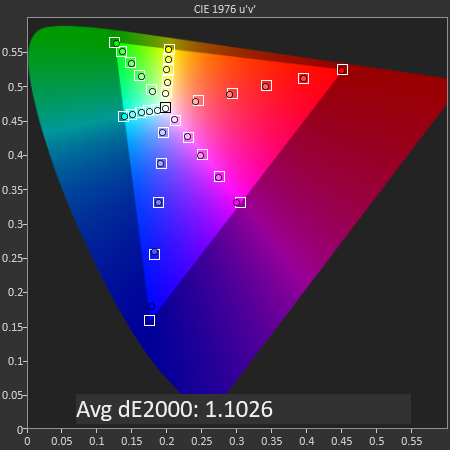
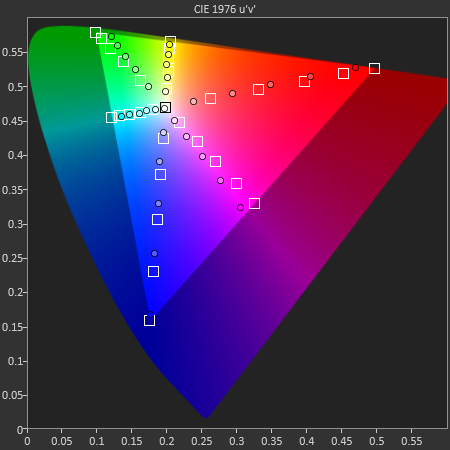 SpectraCal CalMAN
SpectraCal CalMAN
sRGB in "Natural" and in "Boosted" (Against Display P3 Gamut)
When in “Natural” mode, all non-colour managed content targets the sRGB colour-space. Here the Pixel 3’s screen is very accurate with a dE2000 of 1.1, among the best in terms of colour accuracy.
Selecting the “Boosted” mode linearly increases the saturations within the sRGB space – the resulting gamut doesn’t adhere to any standard. The adaptive mode is a complete mess in terms of colour gamut as well as targeting a high gamma of 2.5 – we’ll get back to that into a bit.
Google introduced OS level colour management support in Android 8, however the implementation on the Pixel 2 wasn’t finalised and there wasn’t any application support as of last year. With the Pixel 3 I had hoped that Google would progress on this, however to my great disappointment I didn’t find a single out-of-the box application which would support wide-gamut content.
To demonstrate the issue, you see the Pixel 2, Pixel 3 and an iPhone XS showcasing sRGB and Display P3 images alongside each other in the above photo. By default on Chrome, both sRGB and P3 images are equal, while the XS correctly showcases the higher saturation of the full-level red of the P3 image.
There is one way to bypass this issue, and that is to explicitly tell Chrome to override the default provided system colour profile and just tell it the display is Display P3. This enables colour management in the app, and short of writing a custom application, is the only way to get wide colour gamut content to work on the Pixel 3.
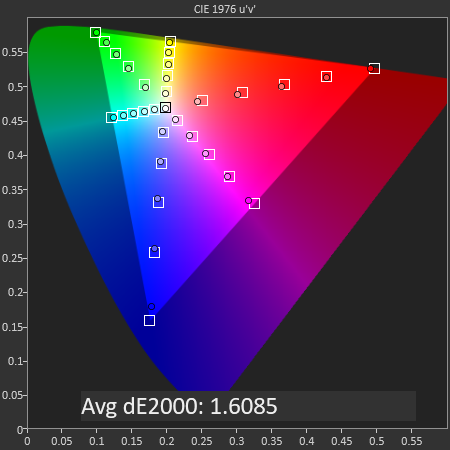
 SpectraCal CalMAN
SpectraCal CalMAN
Display P3 in "Natural" and in "Boosted"
Now one of the big questions I’ve had this year is how the CMS would interact with the actual display colour profiles in the settings. Fortunately, it’s pretty straightforward: The “Natural” mode isn’t per se a colour gamut selection, is just an actual category which has both accurate sRGB and P3 display modes via the CMS.
Testing out the Display P3 targets, the Pixel 3 showcases a good dE2000 result of 1.6. The display didn’t score better because seemingly the blue spectrum isn’t fully hitting the target saturations, something that also happened in the sRGB targets. Testing the P3 targets in the “Boosted” mode, we see again what is happening is that this mode just linearly increases the saturations. The blues are nearer to the P3 targets but all other colours overshoot the P3 target now.

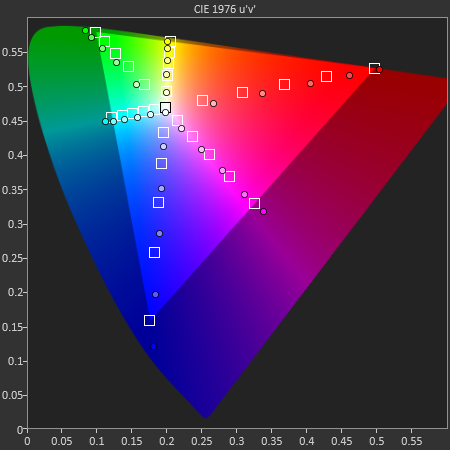 SpectraCal CalMAN
SpectraCal CalMAN
sRGB and Display P3 Targets in "Adaptive"
Now the fun thing is testing what happens with the sRGB and Display P3 images when you’re in “Adaptive” mode. sRGB obviously is quite a disaster – I didn’t manage to match this resulting gamut to any existing standard so there’s no real point in measuring an error rate. Now what is really interesting is to see the CMS expand the resulting visible gamut with the P3 images – here we’re seeing something that is far wider than Display P3, especially in the blues. Again this doesn’t really match any standard gamut, so there’s no point in making direct comparisons.

SpectraCal CalMAN
GretagMacBeth in "Natural"
The GretagMacBeth colour test in natural mode results in accurate colours with a dE2000 of 1.28.
Gamma curves under magnifying glass
One of the reasons I want to switch to full 256 level greyscale testing is to better show case the luminance behaviour, specifically highlighting the issue of “black clipping”.
The Pixel 2 XL, along with the LG V30, suffered very badly from black clipping at low brightness levels. I generally attribute this to the fact that those generation panels just used the DDIC’s ADC bit-depth for both colour representation as well as brightness control. Samsung OLEDs use PWM on top to control brightness by just adjusting the duty level – with voltage of the pixels determining the colour intensity. The Pixel 2 XL and V30 seemed to lack sufficient range to cover the level-spectrum at the low-end, and this resulted in notorious black clipping.
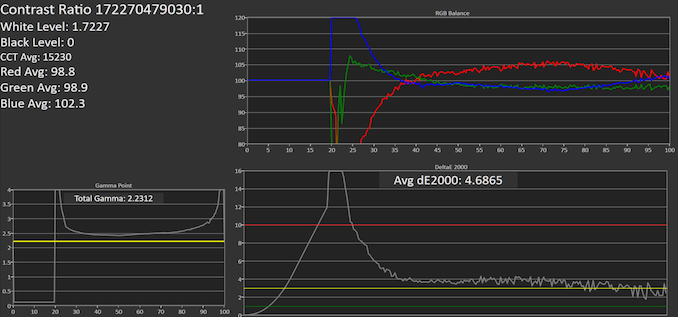
SpectraCal CalMAN
Pixel 2 XL
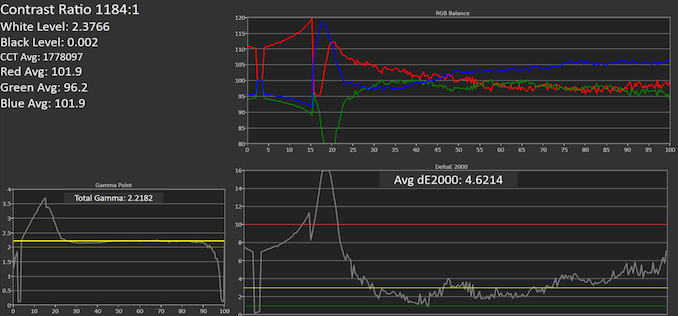 SpectraCal CalMAN
SpectraCal CalMAN
Pixel 3
At minimum brightness, the Pixel 3 improves over the Pixel 2 XL in this regard, but it’s still pretty terrible as it’s clipping 15% of levels to black, as opposed to 25% of the Pixel 2 XL.
The higher the brightness, the less pronounced the issue is. At 200 nits compared across the Pixel 3, Pixel 2 XL, S9+ and an iPhone XS, we see that all of the Android phones are clipping the first few greyscale levels to black, with Apple being the only manufacturer able to perform excellently in this regard.
Also one thing that becomes evident when doing full-scale 256 level measurements is the fact that the Pixel 3 colour balance across levels is very haphazard, and we see quite a zig-zagging behaviour between the intensities at different levels, also represented by the dE2000 results. In absolute terms, this shouldn’t be an issue as overall the error rate is acceptable, however it’s a stark behavioural contrast to any other phone I’ve measured before.
Overall, the Pixel 3’s screen is an improvement over the Pixel 2 XL, however it doesn’t fully solve the low-brightness issues that are plaguing LG’s OLED panels, and Samsung panels such as on the Pixel 2 are still better this this regard.
In terms of colour accuracy, the Pixel 3 performs well. Here I would have hoped that Google would have gotten wide colour gamut support fully working within its applications – currently the only way to get this to work is to change a Chrome settings flag, and this only solves the problem for Chrome, and no other app.
Lastly, the display brightness is good, however again it’s just adequate at up to 400 nits, and fails to compete with super bright displays from competing flagships.


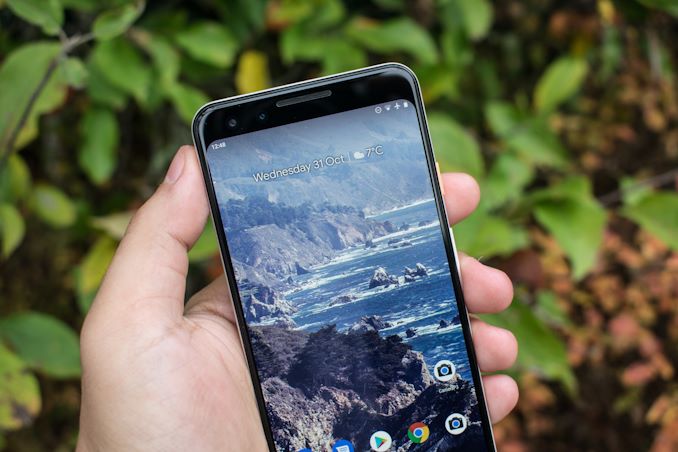
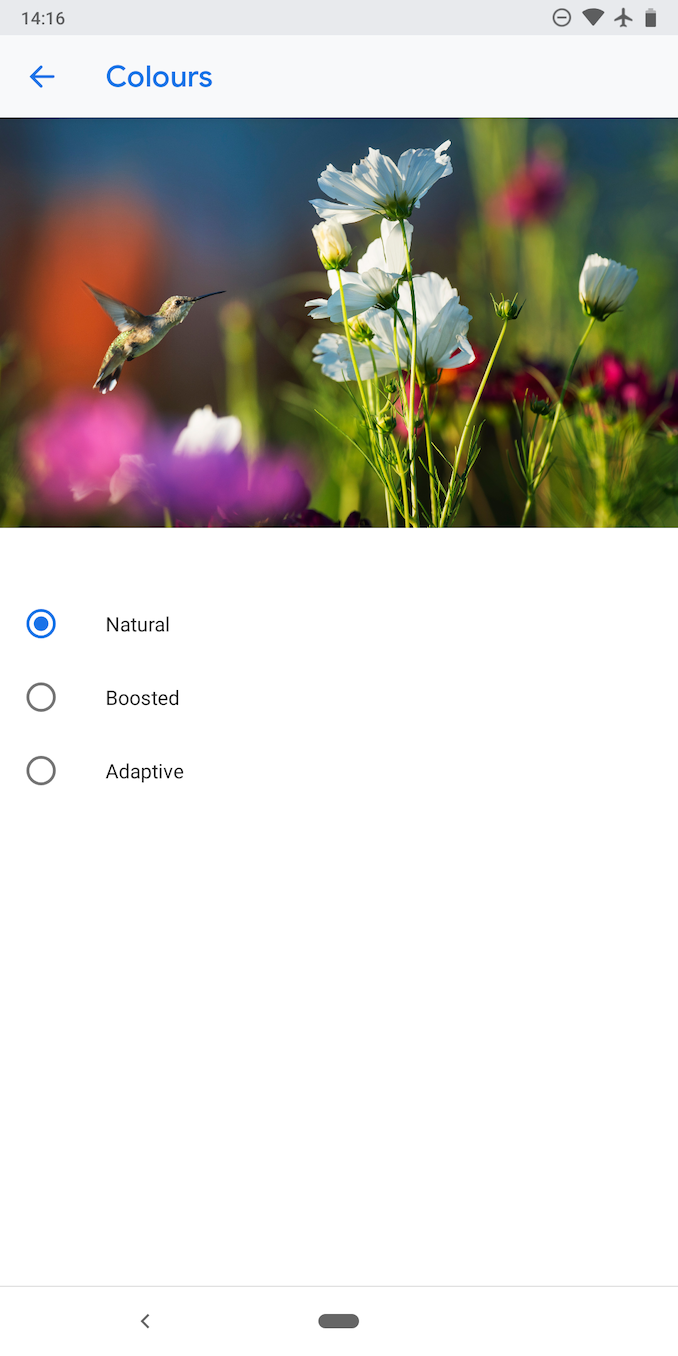
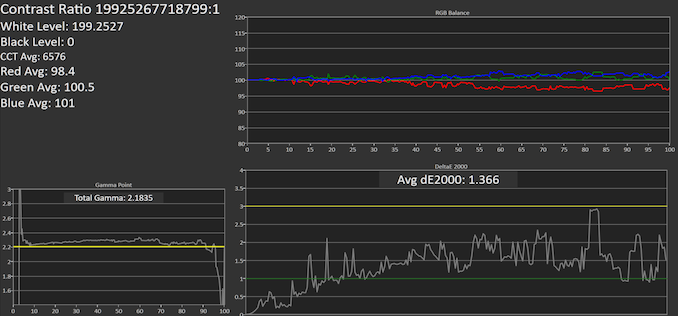

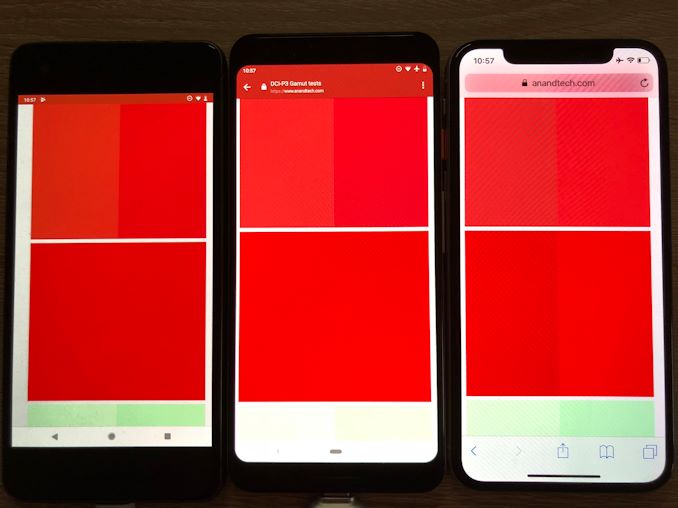
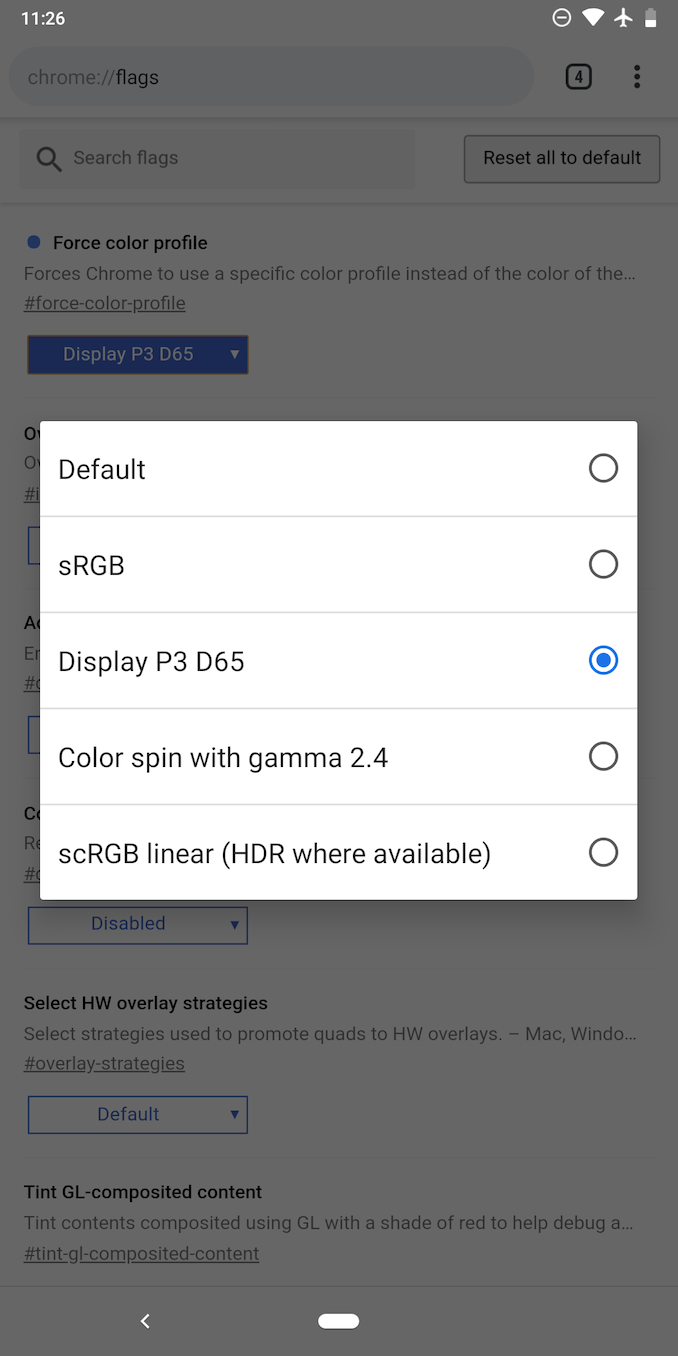









135 Comments
View All Comments
Impulses - Friday, November 2, 2018 - link
Meh, their memory management is still over-aggressive here... Some of the instances I've seen of apps getting killed after opening the camera don't even happen on my OG Pixel with the same amount of RAM.Arbie - Friday, November 2, 2018 - link
Is anyone actually in favor of not having a headphone jack?I get it that you *can* make the phone very slightly thinner without one; OTOH keeping the same thickness *can* permit longer battery life, which everyone wants. I also understand that you *can* put a superlative DAC in a dongle, for audiophiles. But that can be done anyway.
Killing the jack seems to bring no benefit to the majority of folks, and is going to alienate a lot of them. So - why? Such a change can't just be due to fashion.
zanon - Friday, November 2, 2018 - link
Yes, and it blows my mind that so many so-called tech enthusiasts are actually actively against improvements to archaic technology. Wires suck, they get snagged on things, they limit movement, they act as antennas that pick up things like GSM sync signals, etc. We used them because that was the best that could be done in the 70s and 80s. But that's not the case now. They offer literally zero inherent advantages except one: the antenna part, they can in principle (and in a few phones over the years) act as physical antennas for classic radio broadcasts. But that simply hasn't been that motivating to the developed world market in a long time, as evidenced by the fact that it's not a major advertised universal Android feature and Apple never bothered with it at all.Beyond that wireless should be fine, and I think people confuse implementation trouble due to companies doing a bad job or market immaturity with real problems. Audio quality is not an issue, Bluetooth 5 has plenty of bandwidth for even lossless audio (and 256 AAC let alone Sony's fat codec is transparent anyway). Run time is fine, once something gets to 10-18 hours+ on a charge that meets what I'd ever listen to in a single session with no breaks (when it could be charged). Symmetric encryption is cheap and easy now and means it's as secure (or more given TEMPEST) as wired. Some stuff is still lacking, like easy switching between multiple wireless sources, but that's not a fault of the inherent tech so much as there hasn't been any real demand for it yet because wires have hung on so damn long. We're already seeing way more cool adapters for existing products get released due to increased demand and so I expect the market to work it's typical magic.
I'm delighted to see that relic go. I have no nostalgia towards it anymore then I do towards 8-track or MMX or 10base ethernet or whatever.
cfenton - Friday, November 2, 2018 - link
"Beyond that wireless should be fine, and I think people confuse implementation trouble due to companies doing a bad job or market immaturity with real problems."But those are real problems for everyday use. Just because the technology is theoretically there doesn't mean it works well in practice. I use wireless headphones with my Galaxy S7 in the winter because I hate threading a cord through my coat. About 20% of the time my headphones only connect for voice calls, but not media. I have to either fiddle with menus, or turn them off and on again. I'm using a $100+ over-ear set, not some cheap $20 ear-buds from a no-name brand. It's annoying enough that I still use my wired headphones at home, and outside in the summer.
I've heard Apple's solution is a lot better, but I don't have an iPhone, and don't particularly like Beats.
If getting rid of the headphone jack added anything to the phone, or somehow made bluetooth better, I'd be all for it. But it seems to add nothing. Samsung has shown with the Galaxy S9 that you can make a very nice modern phone and still have room for a headphone jack. So why not have both until the real world problems with wireless get worked out?
zanon - Friday, November 2, 2018 - link
But how do you think we have *ever* gotten from A to B there? I'm only in my late-30s so not really old, but even so I can still remember most of the PC era and I can't remember any significant technology that didn't take many years to get refined, to fill out niches, to unambiguously beat what it replaced. Not just in hardware but often even in software, take audio and video codecs for example, there have been a number of replacement cycles where the technically superior standard spec for a while was inferior in practice to highly refined encoders for the previous generation.At some point somebody has to get the ball rolling and there will be a few generations where people just have to deal with compromises. The only way we've ever gotten great tech is for a real market to get established and then iterated upon. In the case of BT audio, in just the last year I've seen more improvements in things like BT adapters then like the previous 5 years at least. Just a few days ago a bunch of BT5 gen 2 refined ones came out at lower prices and better performance.
>"So why not have both until the real world problems with wireless get worked out?"
Because that has never, ever worked. If the old thing is still available major players just use the old thing. Inertia is very powerful. Somebody sometime has to bite the bullet, and given the realities of mass manufacturing you can't "have all the problems worked out" in version 1.0. Version 1.0 is always going to have issues. But you can't get ver2 or ver3 without going through 1.0 first. In this case Apple has shown it can be done very well and with more vendors going that way there is now a clear market of people ready to spend money on it and 3rd parties are starting to react and iterate. Now we can look forward to having way better stuff in another year or 2, whereas if they had all put it off then there is no reason to expect that'd be the case anymore then it was the last decade.
If you really don't want to be on the bleeding edge there then no problem, just get an older device! Mobile lasts a lot longer now, Apple already supports their stuff 5+ years and Google is getting better too. But those of us who like to live nearer the edge have always had to deal with that edge being rougher then those who follow. Somebody has to go first though.
porcupineLTD - Saturday, November 3, 2018 - link
Nice mental gymnastics to justify an idiotic trend.zanon - Saturday, November 3, 2018 - link
Nice brainless technophobia from a luddite lol. Why don't you go back to your retro forum hole and cling to your VGA and CRT claiming they're the best ever and all this flatscreen stuff is a sheeple fad?Impulses - Saturday, November 3, 2018 - link
CRT still haven't been surpassed for some fast refresh applications... And likely never will by LCD, OLED might get there.rabidpeach - Friday, July 31, 2020 - link
it's not technophobia! you can get wired speakers that are sufficiently sensitive that are much bigger than the bs wireless earbuds you insert. likewise the full size wireless bose whatevers. it's not a big range of headphones but there is a sweet spot of larger phones that can be driven by mobile device. it exzists.cfenton - Saturday, November 3, 2018 - link
But we're not on version 1.0 of Bluetooth, we're on version 5.0 and it's still not great. Well, I don't have any 5.0 stuff, so maybe they finally got it right, but version 4.0 is still pretty inconsistent. If wireless worked as well as wired, I'd be all for it, but in my experience, it doesn't yet.As for transitions not happening unless forced, I'm not sure that's true. Lots of people use Wi-Fi even though wired ethernet still exists. It's only in the last five years or so that laptops have been shipping without ethernet ports, and desktops still have them. Again, I'm not against having good wireless tech, I just don't think it's 100% there yet and removing wired connections doesn't seem to add anything to the phone.